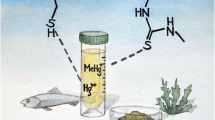Abstract
A new double-spiking approach, based on a multiple-spiking numerical methodology, has been developed and applied for the accurate quantification of inorganic mercury (IHg) and methylmercury (MeHg) by GC–ICPMS in different environmental matrices such as water, sediments and a wide range of biological tissues. For this purpose, two enriched mercury species (201MeHg and 199IHg) were added to the samples before sample preparation in order to quantify the extents of the methylation and demethylation processes, and thereby correct the final species concentrations. A critical evaluation of the applicability of this methodology was performed for each type of matrix, highlighting its main advantages and limitations when correcting for the conversion reactions of the species throughout the whole sample preparation procedure. The double-spike isotope dilution (DSIDA) methodology was evaluated by comparing it with conventional species specific isotope dilution (IDA) when analysing both certified reference materials and environmental samples (water, biotissues and sediment). The results demonstrate that this methodology is able to provide both accurate and precise results for IHg and MeHg when their relative concentrations are not too different (ratio MeHg/IHg > 0.05), a condition that holds for most natural waters and biotissues. Significant limitations on the accurate and precise determination of the demethylation factor are however observed, especially for real sediment samples in which the relative concentrations of the species are substantially different (ratio MeHg/IHg < 0.05). A determination of the sources of uncertainty in the methylation/demethylation factors has demonstrated that the accurate and precise measurement of the isotope ratios in the species involved in the transformations is crucial when quantifying the extents of these reactions. Although the double-spike methodology is established as a reference approach that permits the correction of most analytical biases and the accurate quantification of Hg species, some limitations have been identified for the first time in this work.



Similar content being viewed by others
References
Craig PJ (ed) (1986) Organometallic compounds of environmental sciences: principles and reactions. Longman, Harlow, UK
Stein ED, Cohen Y, Winer AM (1996) Crit Rev Environ Sci Technol 26:1–43
Leermakers M, Baeyens W, Quevauviller P, Horvat M (2005) TrAC 24:383–393
Stoichev T, Amouroux D, Rodriguez Martin-Doimeadios RC, Monperrus M, Donard OFX, Tsalev DL (2006) Appl Spectrosc Rev 41:591–619
Demuth N, Heumann KG (2001) Anal Chem 73:4020–4027
Monperrus M, Tessier E, Veschambre S, Amouroux D, Donard O (2005) Anal Bioanal Chem 381:854–862
Hammerschmidt CR, Fitzgerald WF (2001) Anal Chem 73:5930–5936
Lambertsson L, Lundberg E, Nilsson M, Frech W (2001) J Anal Atom Spectrom 16:1296–1301
Qvarnstrom J, Frech W (2002) J Anal Atom Spectrom 17:1486–1491
Rodriguez Martin-Doimeadios RC, Monperrus M, Krupp E, Amouroux D, Donard OFX (2003) Anal Chem 75:3202–3211
Rodriguez-Gonzalez P, Marchante-Gayon JM, Garcia Alonso JI, Sanz-Medel A (2005) Spectrochim Acta Part B 60:151–207
Heumann KG (2004) Anal Bioanal Chem 378:318–329
Monperrus M, Krupp E, Amouroux D, Donard OFX, Rodriguez Martin-Doimeadios RC (2004) TrAC 23:261–272
Hintelmann H, Ogrinc N (2003) In: Cai Y, Braids CO (eds) Biogeochemistry of environmentally important trace elements. American Chemical Society, Washington, DC, 835:321–338
Hintelmann H, Evans RD (1997) Fresen J Anal Chem 358:378–385
Martin-Doimeadios RCR, Krupp E, Amouroux D, Donard OFX (2002) Anal Chem 74:2505–2512
Monperrus M, Martin-Doimeadios RCR, Scancar J, Amouroux D, Donard OFX (2003) Anal Chem 75:4095–4102
Rodriguez-Gonzalez P, Encinar JR, Alonso JIG, Sanz-Medel A (2004) J Anal Atom Spectrom 19:685–691
Rodriguez-Gonzalez P, Alonso JIG, Sanz-Medel A (2005) J Anal Atom Spectrom 20:1076–1084
Rahman GMM, Kingston HM (2004) Anal Chem 76:3548–3555
Martin-Doimeadios RCR, Stoichev T, Krupp E, Amouroux D, Holeman M, Donard OFX (2002) Appl Organomet Chem 16:610–615
Kragten J (1994) Analyst 119:2161–2165
Acknowledgements
This research is a contribution to the MERCYMS and MERCIS projects, performed in the frameworks of the European Union ELOISE and French ECCO-ECODYN programs, respectively. Some of the field samples investigated were obtained through the intercomparison study performed within the MERCYMS project in collaboration with the Jozef Stefan Institute (Slovenia). LCABIE (Pau) would like to thank Thermo Electron for providing the X7 series ICPMS and the FOCUS GC which were used throughout this study. Pablo Rodriguez-Gonzalez would like to acknowledge the postdoctoral fellowship from the “Secretaria de Estado de Universidades e Investigacion” of the Spanish Ministry of Education and Science.
Author information
Authors and Affiliations
Corresponding author
Rights and permissions
About this article
Cite this article
Monperrus, M., Rodriguez Gonzalez, P., Amouroux, D. et al. Evaluating the potential and limitations of double-spiking species-specific isotope dilution analysis for the accurate quantification of mercury species in different environmental matrices. Anal Bioanal Chem 390, 655–666 (2008). https://doi.org/10.1007/s00216-007-1598-z
Received:
Revised:
Accepted:
Published:
Issue Date:
DOI: https://doi.org/10.1007/s00216-007-1598-z




